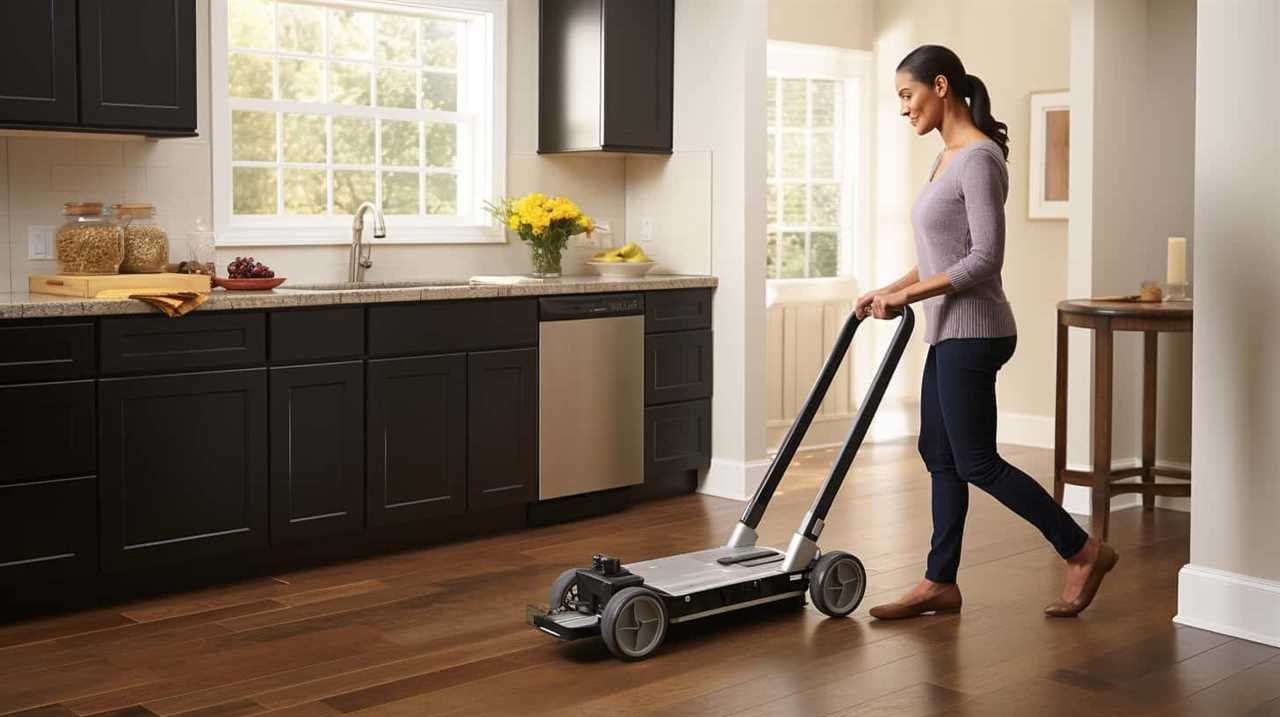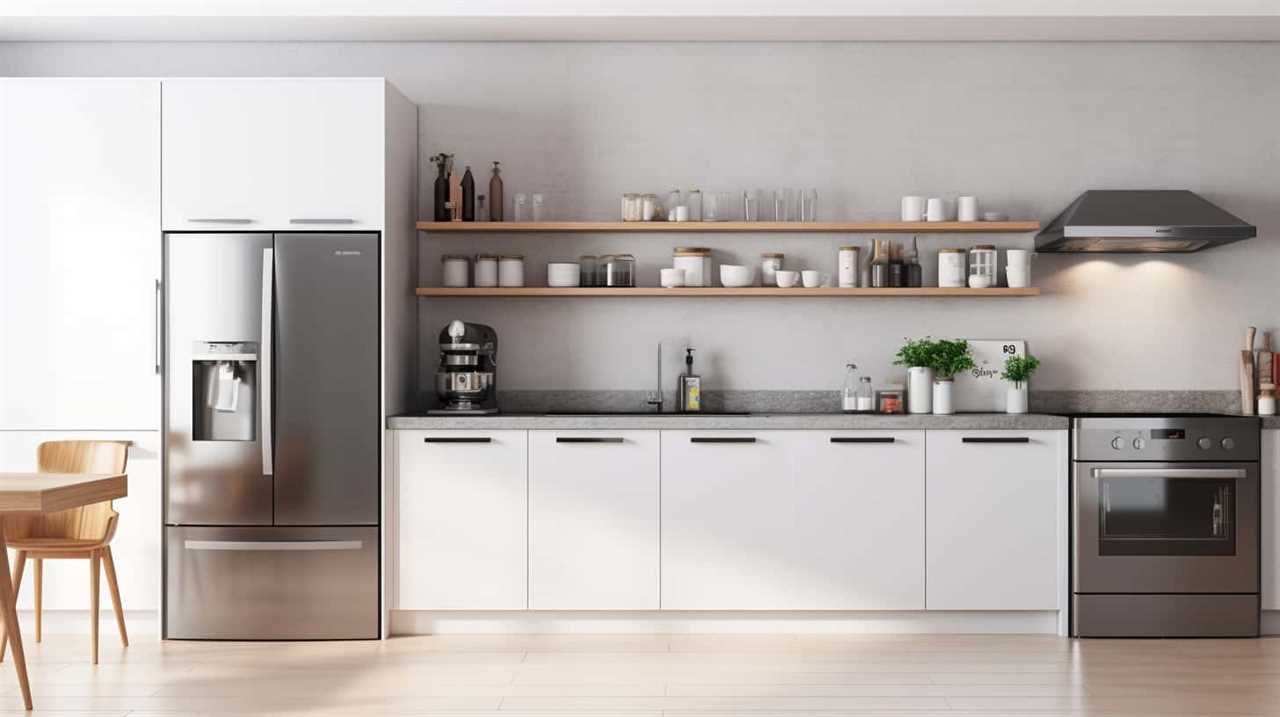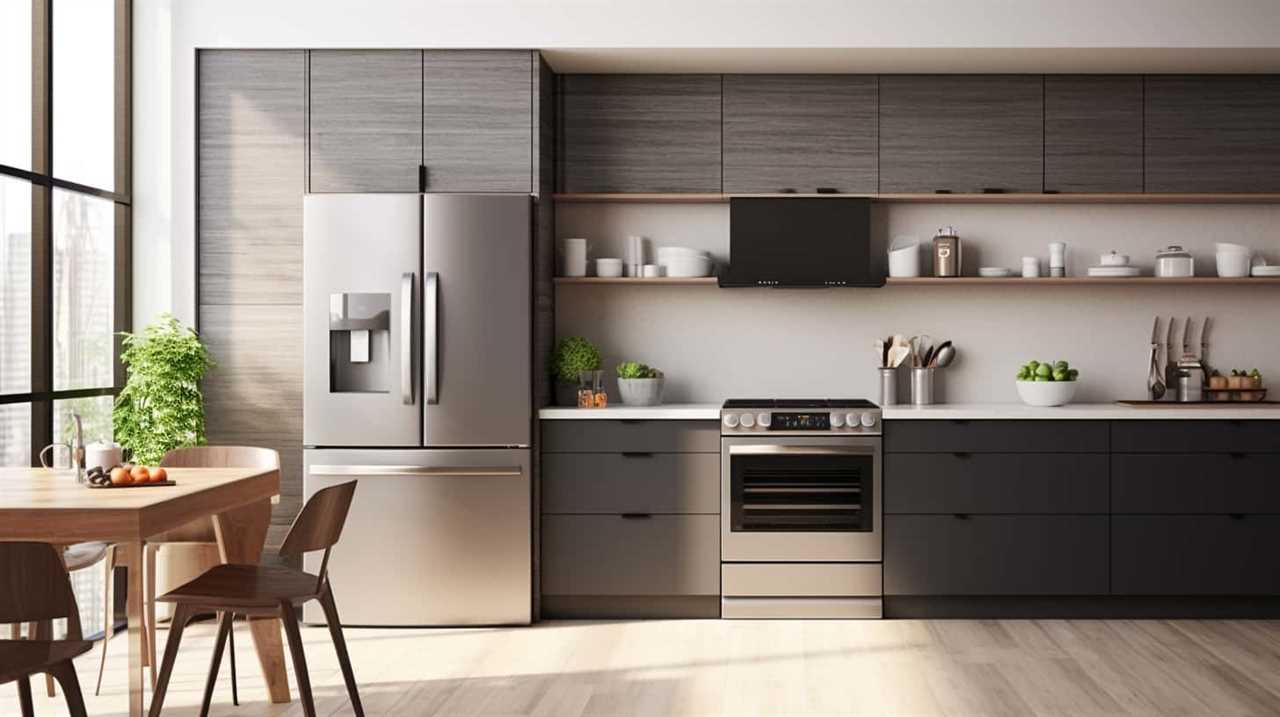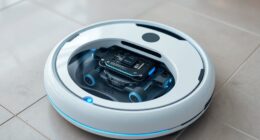We found three incredible advancements that have turned refrigerators into energy-saving wonders.
These advancements not only reduce our carbon footprint, but also save us money on our energy bills.
The first innovation is the implementation of smart sensors, which intelligently regulate the temperature inside the refrigerator, ensuring optimal energy usage.
Next, variable speed compressors have revolutionized the cooling process by adjusting their speed based on the cooling needs, resulting in significant energy savings.

Lastly, the insulation and air-tight seals have been enhanced to minimize heat transfer and maintain a consistent temperature, reducing the energy required for cooling.
With these three innovations, energy-efficient refrigerators have become a reality, providing us with a sustainable and cost-effective solution for preserving our food.
Key Takeaways
- Smart sensors and energy monitoring capabilities enable real-time tracking and optimization of energy usage in refrigerators.
- Variable speed compressors adjust their speed based on cooling demands, leading to better energy management and improved performance.
- Insulation and air-tight seals minimize heat transfer and prevent air leakage, resulting in maximum energy efficiency.
- Energy-efficient refrigerators reduce carbon footprint, save money on energy bills, and promote sustainability and environmental conservation.
Smart Sensors for Energy Savings
Smart sensors play a crucial role in our energy-efficient refrigerators, constantly monitoring and adjusting settings to maximize energy savings. These sensors enable precise energy monitoring, allowing the refrigerator to operate at the optimal temperature and humidity levels. By continuously analyzing the internal conditions, the sensors can determine when to activate adaptive defrosting, ensuring that frost buildup is minimized while minimizing energy consumption.
The energy monitoring capabilities of these smart sensors are essential for maintaining energy efficiency. They provide real-time data on energy usage, allowing users to track and optimize their energy consumption patterns. With this information, homeowners can make informed decisions about their energy usage and reduce their carbon footprint.

In addition to energy monitoring, smart sensors enable adaptive defrosting. Traditional refrigerators use a fixed schedule for defrosting, regardless of the actual frost buildup. This can lead to unnecessary energy consumption. However, with smart sensors, the refrigerator can detect when defrosting is needed and adjust the defrost cycle accordingly. This ensures that energy is only used when necessary, resulting in significant energy savings over time.
As we transition into the subsequent section about variable speed compressors, it’s important to note that smart sensors work in conjunction with these compressors to further enhance energy efficiency.
Variable Speed Compressors
To enhance the energy efficiency of refrigerators, we utilize variable speed compressors. These compressors are a key component in optimizing the cooling process and reducing energy consumption. Unlike traditional fixed-speed compressors that operate at a constant speed, variable speed compressors adjust their speed based on the cooling demands of the refrigerator.
The use of variable speed compressors allows for better energy management and improved performance. By adjusting the compressor speed to match the required cooling load, energy wastage is minimized. This smart control mechanism ensures that the compressor operates at the most efficient speed, resulting in significant energy savings.

In addition to energy efficiency, variable speed compressors offer other benefits as well. They provide more precise temperature control, ensuring that the refrigerator maintains a consistent and optimal temperature. This helps to preserve the freshness and quality of the stored food.
To illustrate the advantages of variable speed compressors, let’s take a look at the comparison table below:
| Traditional Fixed-Speed Compressors | Variable Speed Compressors |
|---|---|
| Operates at a constant speed | Adjusts speed based on cooling demands |
| Less precise temperature control | More precise temperature control |
| Higher energy consumption | Lower energy consumption |
| Limited flexibility | Offers better energy management |
Insulation and Air-Tight Seals
For optimal energy efficiency, we focus on the insulation and air-tight seals of refrigerators. These two components play a crucial role in minimizing energy loss and maintaining the desired temperature inside the refrigerator.
Insulation is the key to preventing heat transfer between the inside and outside of the refrigerator. Energy-efficient materials with low thermal conductivity are used to create an effective barrier. These materials, such as polyurethane foam, are designed to minimize the flow of heat, keeping the cold air inside and the warm air outside. The thickness and quality of the insulation are significant factors in determining the energy efficiency of a refrigerator.

Air-tight seals are equally important in preventing air leakage. These seals, typically made of rubber or silicone, create a tight barrier between the refrigerator door and the body. When the door is closed, the seals ensure that no air can escape or enter the refrigerator, thus minimizing energy waste. Regular maintenance and replacement of damaged seals are essential to maintain their effectiveness.
Frequently Asked Questions
Are Energy-Efficient Refrigerators More Expensive Than Regular Refrigerators?
Energy-efficient refrigerators, in the energy efficient refrigerator market, can be more expensive upfront than regular refrigerators. However, they offer significant cost-saving benefits in the long run.
These appliances are designed to consume less energy, resulting in lower electricity bills. The initial investment is offset by the savings in energy consumption, making energy-efficient refrigerators a wise choice for those looking to reduce their carbon footprint and save money over time.
Can I Retrofit My Existing Refrigerator With Smart Sensors and Variable Speed Compressors to Make It More Energy-Efficient?
Yes, retrofitting options such as smart sensors and variable speed compressors can make your existing refrigerator more energy-efficient. These cost-effective upgrades can help reduce energy consumption and lower your electricity bills.

By installing smart sensors, you can optimize temperature settings and avoid wasteful energy usage. Variable speed compressors adjust their speed based on cooling demands, resulting in better energy efficiency.
Retrofitting your refrigerator with these innovations can be a smart investment for long-term energy savings.
How Do Smart Sensors in Energy-Efficient Refrigerators Work?
Smart sensors in energy-efficient refrigerators work by monitoring and adjusting the temperature and humidity levels inside the fridge. These sensors detect any changes in the environment and send signals to the compressor to adjust its speed accordingly.
This ensures that the compressor runs at the optimal speed, reducing energy consumption and extending the lifespan of the refrigerator.

The variable speed compressors also offer significant benefits, such as improved cooling efficiency, reduced noise levels, and better temperature control.
What Are the Benefits of Variable Speed Compressors in Energy-Efficient Refrigerators?
Variable speed compressors in energy-efficient refrigerators offer several benefits.
By adjusting the compressor’s speed based on cooling demand, they optimize energy usage and reduce power consumption. This results in significant energy savings and lower utility bills.
Additionally, variable speed compressors contribute to a quieter and more efficient operation of the refrigerator.

When combined with smart sensors, which constantly monitor temperature and adjust cooling accordingly, these innovations greatly enhance energy efficiency and overall performance of modern refrigerators.
How Do Insulation and Air-Tight Seals Contribute to the Energy Efficiency of Refrigerators?
Insulation and air-tight seals play a crucial role in enhancing the energy efficiency of refrigerators.
By minimizing heat transfer, insulation prevents the escape of cold air and reduces the workload on the compressor. This results in lower energy consumption and greater cost savings.
Additionally, air-tight seals ensure that the refrigerator remains sealed tightly, preventing warm air from entering and cool air from escaping. This further enhances the efficiency of the refrigerator, making it a vital component in energy-efficient designs.

Conclusion
In conclusion, the advancements in energy-efficient refrigerators have paved the way for significant energy savings.
The use of smart sensors allows for precise temperature control, resulting in reduced energy consumption.
Variable speed compressors ensure that the fridge operates at optimal efficiency based on its cooling needs.
Additionally, insulation and air-tight seals prevent any loss of cool air, further enhancing energy efficiency.

As a result, these innovations have led to an impressive statistic: energy-efficient refrigerators can reduce energy consumption by up to 40%.










